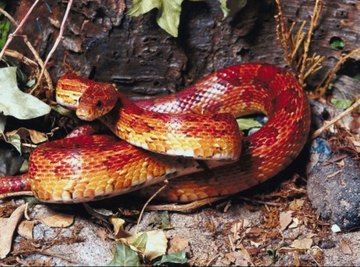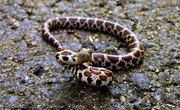
Most snake species are nonvenomous, meaning they do not have venom in their teeth or fangs. The venom of snakes is used to paralyze their prey. Since they do not have venom, nonvenomous snakes subdue their prey via constriction, or squeezing their victims in order to suffocate them. Nonvenomous snakes will bite to defend themselves, though. Forests, grasslands and aquatic areas are the main habitats of Georgia's nonvenomous snakes.
Lampropeltis
Lampropeltis is the scientific genus name for king snakes. In Georgia, four species of king snakes may be found: scarlet king snake, milk snake, eastern king snake and mole king snake. The scales on king snakes are shiny, which is why they fall under the Lampropeltis genus; in Greek, lampropeltis means “shiny shield.” King snakes are known for eating other snakes, including other king snakes and venomous species; the venom in venomous snakes do not have any affect on king snakes. Scarlet king snakes and milk snakes have similar skin patterns as the venomous coral snake. The coral snake has a red-yellow-black pattern, while these two king snakes have red-black-white patterns.
Nerodia
The Nerodia genus of snakes comprise of nonvenomous water snakes. The redbelly, brown, northern, green, diamondback and banded water snakes are all the Nerodia snakes in Georgia. These snakes swim with their entire body, except their head, underwater. This style of swimming differs from venomous snakes, which swim with their entire body on the water's surface. As their name suggests, water snakes spend most their lives in aquatic habitats. The name's of each water snake also describes their skin color – redbellies have red belly areas and brown water snakes are brown-skinned. Physical characteristics of Nerodia snakes include flat head and their scales have ridges.
Regina
Also referred to as crayfish snakes, the Regina genus of snakes have three species in Georgia: glossy crayfish snake, striped crayfish snake and queen snake. These snakes receive their common name from the staple of their diet, crayfish. Glossy crayfish snakes have shiny skin, while striped crayfish snakes features stripes. However, the stripes of striped crayfish snakes are on the creature's belly. Queen snakes are solid black on their dorsal areas, and cream stripes run down the length of their bellies. Since they dine on crayfish, most Regina snakes live in aquatic habitats such as riverbeds and lakes.
Virginia
Two species of the Virginia genus of snakes live in Georgia, the rough earth snake and smooth earth snake. As their names imply, rough earth snakes have rough, ridged scales, while smooth earth snakes possess smoother scales than their counterpart. Both of Georgia's earth snake species are fossorial, which means they spend the majority of their time below the earth's surface, rotten logs or loose soil. As adults, these snakes grow up to 7 to 10 inches. Due to their small size, the main dietary items of earth snakes include insects and invertebrates.
References
About the Author
Skip Davis has been writing professionally since 2005. His work has appeared in "Southern Literary Magazine," on various websites and in graphic panels at the Jackson Zoological Park in Jackson, Miss. Currently living in Southern California, Davis received his Bachelor of Arts in theater at Belhaven College.
Photo Credits
Jupiterimages/Photos.com/Getty Images
